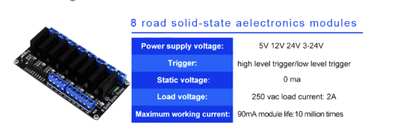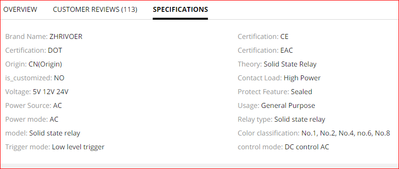These I do use and they are good, fit nicely, unlike the 4 terminal kind.
I reccomend these as a cheap and effective choice, unless you need a heavy duty cycle. Ideal for testing.
Ron B
Ron Bentley
Creativity is an input to innovation and change is the output from innovation. Braden Kelley
A computer is a machine for constructing mappings from input to output. Michael Kirby
Through great input you get great output. RZA
Gauss is great but Euler rocks!!
Hi @ronbentley1,
Sorry, if I missed earlier forum conversations that may have provided context, but so far as I can see in this conversation, there is no mention of what task these relays will be doing, or what voltages and currents, beyond 'low voltage dc'. Obviously, you have an application in mind, but I have no visibility of that application from keyboard and screen.
'Low voltage' depends upon the context .. to the electricity distribution voltage 'low voltage' in my part of the world usually means less than 1000V. I'm guessing you are thinking of a much lower figure, but I don't know what. The same applies to currents, transients and all of the other factors I have mentioned.
At the moment the scope is like saying you want 'a means of transport' ... you could be thinking of a bicycle, a jumbo jet or an ocean liner.
Even the control side is still open, though that is less concerning - Most Arduinos use 5V GPIOs, but a few Arduinos and the ESP32/ESP8266s are all 3.3V GPIOs. It is possible to employ conversion from 3.3V to 5V (and vice versa), but it introduces more components and complexity. To attempt a sensible recommendation, it is necessary to be more specific.
Sorry if this sounds like I am being awkward but I can only read data sheets, not minds. 😀
Best wishes, Dave
@ronbentley1 Just off the top of my head, I don't recall seeing a breadboard toggle switch but I just googled that and got lots of hits.
First computer 1959. Retired from my own computer company 2004.
Hardware - Expert in 1401, and 360, fairly knowledge in PC plus numerous MPU's and MCU's
Major Languages - Machine language, 360 Macro Assembler, Intel Assembler, PL/I and PL1, Pascal, Basic, C plus numerous job control and scripting languages.
Sure you can learn to be a programmer, it will take the same amount of time for me to learn to be a Doctor.
@ronbentley1 They do seem hard to find. SPST doesn't result in any google results that can be called breadboard.
First computer 1959. Retired from my own computer company 2004.
Hardware - Expert in 1401, and 360, fairly knowledge in PC plus numerous MPU's and MCU's
Major Languages - Machine language, 360 Macro Assembler, Intel Assembler, PL/I and PL1, Pascal, Basic, C plus numerous job control and scripting languages.
Sure you can learn to be a programmer, it will take the same amount of time for me to learn to be a Doctor.
Thanks Dave, you can be as pedantic as you wish if it gets a better outcome!
I have an 8 x mechanical relay which offers two output presentations per relay - NC, COMMON and NO.
These do what I want and will switch both ac and dc
However, i have found that this type of relay has a high failure rate and dont seem to do too well if used for longish periods, they just seem to fail.
So I'm looking for a solid state relay to replace these. I have one already but this only works for ac and voltages >75 v.
Btw, I'm not into making one.
Hope this helps.
Ron B
@ronbentley1 If by fail you mean the relay contacts become stuck together, or become so pitted they no longer mnake contact, then you either need a relay with higher specs on the load side or some sort of RC network to slow down the current surge.
If however the inout coil is getting fried, the relay is the wrong size for the job.
Perhaps some specs would help, both of the relay being fried and what your supply and load specs are.
First computer 1959. Retired from my own computer company 2004.
Hardware - Expert in 1401, and 360, fairly knowledge in PC plus numerous MPU's and MCU's
Major Languages - Machine language, 360 Macro Assembler, Intel Assembler, PL/I and PL1, Pascal, Basic, C plus numerous job control and scripting languages.
Sure you can learn to be a programmer, it will take the same amount of time for me to learn to be a Doctor.
Hi Dave,
I clearly asked a fundamentally flawed question!
On the control side then the controlling boards would arduino and/or ESP32 so 5v or 3.3v.3v
On the switching side, then by low dc voltage I mean 12v or less.
As for mechanical relays then there is a good deal on the net about their reliability, just as I have found. I am very certain that I have never tried one. They just fail!
Ron B
Ron Bentley
Creativity is an input to innovation and change is the output from innovation. Braden Kelley
A computer is a machine for constructing mappings from input to output. Michael Kirby
Through great input you get great output. RZA
Gauss is great but Euler rocks!!
The mechanical ones I have used have just proved to be unreliable, hence my post for a solid state equivalent but specifically to handle low dc on the switching side, ie 12v or less and 3.3v or 6v on the control side.
Ron B
Ron Bentley
Creativity is an input to innovation and change is the output from innovation. Braden Kelley
A computer is a machine for constructing mappings from input to output. Michael Kirby
Through great input you get great output. RZA
Gauss is great but Euler rocks!!
Ron Bentley
Creativity is an input to innovation and change is the output from innovation. Braden Kelley
A computer is a machine for constructing mappings from input to output. Michael Kirby
Through great input you get great output. RZA
Gauss is great but Euler rocks!!
Ron Bentley
Creativity is an input to innovation and change is the output from innovation. Braden Kelley
A computer is a machine for constructing mappings from input to output. Michael Kirby
Through great input you get great output. RZA
Gauss is great but Euler rocks!!
Hi @ronbentley1,
So we are starting to home in on a draft specification.
So far:
- 12V DC or less
Not yet knowns:
- Current ... certainly need to know the maximum 'steady state, continuous' current
- Nature of load? Is this for a model railway engine? It is heading towards 60 years since I last handled them, so any guesses are very wild. Plus I assume it depends upon the gauge etc. I'll put a couple of guesses here for illustration, but you really need some 'proper' data:
- continuous current, 'full speed' .. maybe 1 Amp?
- Peak current ... any brushed DC motors take a high peak current when they are not moving, so I guess this could be 3A ?
- voltage transients .. inductive nature of motors suggest voltage spikes are likely .. maybe diodes to absorb the energy?
- How do you control the speed? Is it under computer control?
- Are there other load types to consider? e.g. lights, points?
--------------
Sorry this may seem like a drawn out process, but designing a system is not trivial and as I mentioned and Ron (@zander) has emphasised, your relays were probably failing due to overstress. Knowing their rating would also help to provide a very rough guide as to how 'hostile' the job is.
Best wishes, Dave
Let me try and make my life a little simpler.
The unit I'm looking to replace for a solid state equivalent is:
I do not wish to build one or concoct one, just buy one.
Hope this helps.
Ron B
Ron Bentley
Creativity is an input to innovation and change is the output from innovation. Braden Kelley
A computer is a machine for constructing mappings from input to output. Michael Kirby
Through great input you get great output. RZA
Gauss is great but Euler rocks!!
@ronbentley1 I see you are in UK, so maybe search AliExpress.
First computer 1959. Retired from my own computer company 2004.
Hardware - Expert in 1401, and 360, fairly knowledge in PC plus numerous MPU's and MCU's
Major Languages - Machine language, 360 Macro Assembler, Intel Assembler, PL/I and PL1, Pascal, Basic, C plus numerous job control and scripting languages.
Sure you can learn to be a programmer, it will take the same amount of time for me to learn to be a Doctor.
First computer 1959. Retired from my own computer company 2004.
Hardware - Expert in 1401, and 360, fairly knowledge in PC plus numerous MPU's and MCU's
Major Languages - Machine language, 360 Macro Assembler, Intel Assembler, PL/I and PL1, Pascal, Basic, C plus numerous job control and scripting languages.
Sure you can learn to be a programmer, it will take the same amount of time for me to learn to be a Doctor.
Thanks Ron, I've had a quick look and this module and appears only to handled switched ac, I'm seeking low voltage/current dc switching:
I will give AliExpress a look over.
many thanks
Ron B
Ron Bentley
Creativity is an input to innovation and change is the output from innovation. Braden Kelley
A computer is a machine for constructing mappings from input to output. Michael Kirby
Through great input you get great output. RZA
Gauss is great but Euler rocks!!
@ronbentley1 I just ran across the following. It's a UK company and it says DC to DC so maybe ?
First computer 1959. Retired from my own computer company 2004.
Hardware - Expert in 1401, and 360, fairly knowledge in PC plus numerous MPU's and MCU's
Major Languages - Machine language, 360 Macro Assembler, Intel Assembler, PL/I and PL1, Pascal, Basic, C plus numerous job control and scripting languages.
Sure you can learn to be a programmer, it will take the same amount of time for me to learn to be a Doctor.


